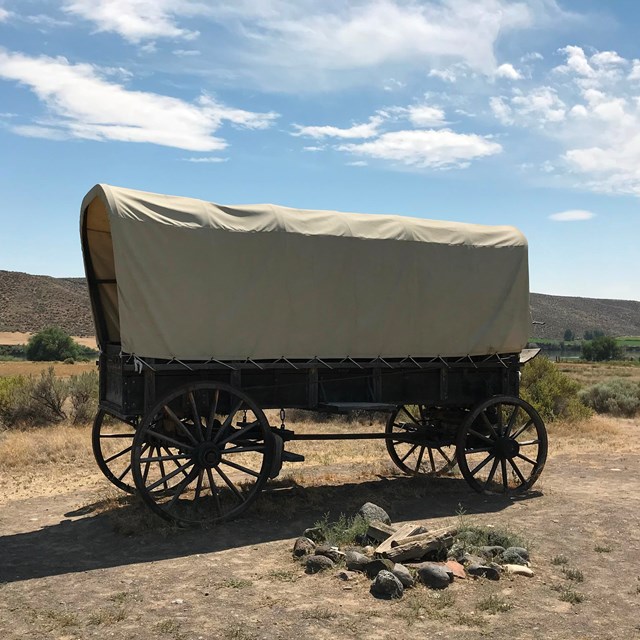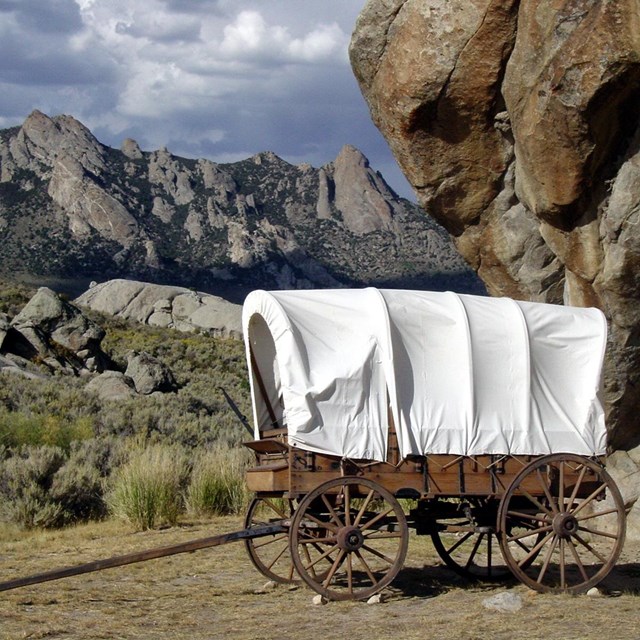Last updated: March 28, 2022
Article
Chapter 1: Race, Slavery, and Freedom - No Rights to be Respected
Sweet Freedom's Plains
African Americans on the Overland Trails 1841-1869
By Shirley Ann Wilson Moore, PhD.
For the National Park Service
National Trails Regions 6, 7, & 8
Introduction/Table of Contents
Chapter 1 Sections
- The Early Black Presence
- The Question of Race
- The Evolution of Their Status
- The Contagion of Liberty
- Permanent, Hereditary Chattel: A Snapshot of Antebellum Slavery in the South, Indian Territory, and Border States
- Northern “Unfreedom”
- The Nature of Freedom in the West
- Utah: Slaves and Saints
- No Rights to be Respected
The landmark Dred Scott decision of 1857 left no doubt about the precarious situation in which nineteenth-century African Americans lived. This ruling increased the vulnerability of all blacks, regardless of residency or region, to enslavement or re-enslavement.90 Dred Scott was a Virginia-born slave owned by John Emerson, an army doctor living in Missouri. Emerson took Scott along when he was transferred to posts in the free state of Illinois and the free territory of Wisconsin in the 1830s. While on free soil in 1836 or 1837, Scott married Harriet Robinson, a teen-age slave owned by Major Lawrence Taliaferro, the Indian agent for Wisconsin Territory. (see Appendix, Chapter 1, Photo 3). In October of 1837, Emerson left Fort Snelling for an assignment in Saint Louis, leaving Dred and Harriet in Wisconsin to be hired out. Emerson was subsequently posted to Louisiana, where he married Eliza Irene Sanford in February 1838. The Emersons demanded that Dred and Harriet Scott join them in Louisiana, and the black couple voluntarily traveled back to the slave state. In September 1838, the Emersons and the Scotts stopped in St. Louis and then moved on to Fort Snelling. While en route, Harriet gave birth to the couple’s first child, Eliza, in October 1838. Next, Emerson was transferred to Florida in May 1840, leaving his wife and his slaves in St. Louis with his father-in-law, Alexander Sanford, who hired out Dred and Harriet. In 1842, Emerson returned to St. Louis and moved to Davenport, Iowa, with his wife, but left his slaves in Missouri.91
Emerson died unexpectedly in December 1843, and three years after his death, Dred and Harriet Scott, with the support of white friends and attorneys, filed separate law suits in Missouri courts for their freedom. They argued that because they had resided where slavery was illegal, they had become forever free. They had a strong case under long-standing Missouri legal precedence that held “once free, always free” in adjudicating freedom suits. Harriet Scott’s suit was set aside pending the outcome of her husband’s claim.92 Scott lost his first suit, won his second, and lost again on appeal in the Missouri Supreme Court and again in the U.S. Circuit Court. In the final appeal, Dred Scott v. Sanford, the United States Supreme Court, with chief justice Roger B. Taney of Maryland writing for the majority (who were predominantly Southerners), ruled that black people “had no rights which the white man was bound to respect; and that the negro might justly and lawfully be reduced to slavery for his [the white man’s] benefit.” The 1857 decision held that Scott was not a free man even though he had lived in areas where slavery was illegal. The court also maintained that Scott and all slaves were property, and that Congress could not pass legislation (including the Missouri Compromise or the Kansas-Nebraska Act) that would prevent slave owners from taking their human property into any territory.93
After the ruling, the Scotts’ new owner, Dr. Calvin Chaffee, a Massachusetts abolitionist and member of Congress who married John Emerson’s widow, Irene, eventually freed Dred and Harriet. The couple later settled in St. Louis, Missouri, where Harriet worked as a laundress and Dred was employed as a porter at the Barnum Hotel. In 1858, less than 16 months after gaining his freedom, Dred Scott died of tuberculosis. In 1876, Harriet died in St. Louis, where she had resided since her husband’s death with her daughter and son-in-law, Lizzie Scott Madison and Wilson Madison.94
The Dred Scott ruling became the most important legal decision on the issues of slavery, freedom, and race in antebellum America. It legally stripped African Americans of their personhood and legitimated the practices of slave-catchers who scoured the country for runaways or any black person they might encounter. Moreover, the ruling further entrenched the institution of slavery in the nation’s economic and social life, outraging abolitionists and heartening pro-slavery forces.95 Many African Americans, enslaved and free, undertook their overland journeys within this harsh political and social milieu. The racial laws and customs of nineteenth-century America informed their every step across the plains.
Chapter Two: The Jumping Off-Places
90 For an account of a free-born, Northern African American who was kidnapped and enslaved, see Solomon Northrup, Twelve Years a Slave, ed. Sue Eakin and Joseph Logsdon (1853; repr., Baton Rouge: Louisiana State University Press, 1979). For vulnerability of escaped slaves in the north, see Jean Fagan Yellin, Harriet Jacobs: A Life (Cambridge: Basic Civitas, 2004), especially 41, 49, and 109-111.
91 Missouri State Archives, “Missouri’s Dred Scott Case, 1846-1857,” the Missouri Digital Heritage Collections, African American History Initiative, http://www.sos.mo.gov/archives/resources/africanamerican/scott/scott.asp [accessed May 19, 2011].
92 Missouri law held that slaves who were taken to free states or territories were freed, even if they returned to the slave state of Missouri. Missouri’s judicial standard maintained that once the bonds of slavery had been broken, they did not reattach. See Missouri State Archives, “Missouri’s Dred Scott Case.”
93 For Taney’s opinion, see Taney, Opinion of the Court, U.S. Supreme Court, Scott v. Sandford, 60 U.S. 393, Cornell University Law School, Legal Information Institute, http://www.law.cornell.edu/supct/html/historics/USSC_CR_0060_0393_ZO.html [accessed May 20, 2011]; U.S. Supreme Court, Dred Scott v. Sanford, 60, U.S. 393 (December Term 1856), Westlaw, http://laws.findlaw.com/us/60/393.html [accessed May 19, 2011].
94 Missouri State Archives, “Missouri’s Dred Scott Case.”
95 For an examination of the Dred Scott case and its legal, social, cultural, and political implications, see David Thomas Konig, Paul Finkelman, and Christopher Alan Bracey, eds., The Dred Scott Case: Historical and Contemporary Perspectives on Race and Law (Athens, Ohio: Ohio University Press, 2010). For a comprehensive examination of the Dred Scott decision, see Don E. Fehrenbacher, The Dred Scott Case: Its Significance in American Law and Politics (New York: Oxford University Press, 1979).




